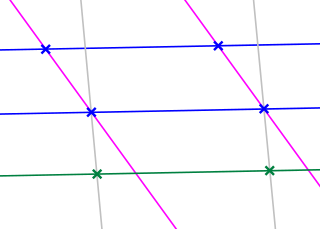Related Research Articles

In mathematics, a projective plane is a geometric structure that extends the concept of a plane. In the ordinary Euclidean plane, two lines typically intersect at a single point, but there are some pairs of lines that do not intersect. A projective plane can be thought of as an ordinary plane equipped with additional "points at infinity" where parallel lines intersect. Thus any two distinct lines in a projective plane intersect at exactly one point.

In mathematics, the concept of a projective space originated from the visual effect of perspective, where parallel lines seem to meet at infinity. A projective space may thus be viewed as the extension of a Euclidean space, or, more generally, an affine space with points at infinity, in such a way that there is one point at infinity of each direction of parallel lines.
In mathematics, projective geometry is the study of geometric properties that are invariant with respect to projective transformations. This means that, compared to elementary Euclidean geometry, projective geometry has a different setting, projective space, and a selective set of basic geometric concepts. The basic intuitions are that projective space has more points than Euclidean space, for a given dimension, and that geometric transformations are permitted that transform the extra points to Euclidean points, and vice versa.

In mathematics, affine geometry is what remains of Euclidean geometry when ignoring the metric notions of distance and angle.

A finite geometry is any geometric system that has only a finite number of points. The familiar Euclidean geometry is not finite, because a Euclidean line contains infinitely many points. A geometry based on the graphics displayed on a computer screen, where the pixels are considered to be the points, would be a finite geometry. While there are many systems that could be called finite geometries, attention is mostly paid to the finite projective and affine spaces because of their regularity and simplicity. Other significant types of finite geometry are finite Möbius or inversive planes and Laguerre planes, which are examples of a general type called Benz planes, and their higher-dimensional analogs such as higher finite inversive geometries.

In projective geometry, Desargues's theorem, named after Girard Desargues, states:
In geometry, an affine plane is a system of points and lines that satisfy the following axioms:
In mathematics, incidence geometry is the study of incidence structures. A geometric structure such as the Euclidean plane is a complicated object that involves concepts such as length, angles, continuity, betweenness, and incidence. An incidence structure is what is obtained when all other concepts are removed and all that remains is the data about which points lie on which lines. Even with this severe limitation, theorems can be proved and interesting facts emerge concerning this structure. Such fundamental results remain valid when additional concepts are added to form a richer geometry. It sometimes happens that authors blur the distinction between a study and the objects of that study, so it is not surprising to find that some authors refer to incidence structures as incidence geometries.
In mathematics, a translation plane is a projective plane which admits a certain group of symmetries. Along with the Hughes planes and the Figueroa planes, translation planes are among the most well-studied of the known non-Desarguesian planes, and the vast majority of known non-Desarguesian planes are either translation planes, or can be obtained from a translation plane via successive iterations of dualization and/or derivation.

Joseph Henry Maclagan Wedderburn FRSE FRS was a Scottish mathematician, who taught at Princeton University for most of his career. A significant algebraist, he proved that a finite division algebra is a field, and part of the Artin–Wedderburn theorem on simple algebras. He also worked on group theory and matrix algebra.
In mathematics, an algebraic structure consisting of a non-empty set and a ternary mapping may be called a ternary system. A planar ternary ring (PTR) or ternary field is special type of ternary system used by Marshall Hall to construct projective planes by means of coordinates. A planar ternary ring is not a ring in the traditional sense, but any field gives a planar ternary ring where the operation is defined by . Thus, we can think of a planar ternary ring as a generalization of a field where the ternary operation takes the place of both addition and multiplication.
In mathematics, a quasifield is an algebraic structure where and are binary operations on , much like a division ring, but with some weaker conditions. All division rings, and thus all fields, are quasifields.
In mathematics, a near-field is an algebraic structure similar to a division ring, except that it has only one of the two distributive laws. Alternatively, a near-field is a near-ring in which there is a multiplicative identity and every non-zero element has a multiplicative inverse.

In projective geometry an oval is a point set in a plane that is defined by incidence properties. The standard examples are the nondegenerate conics. However, a conic is only defined in a pappian plane, whereas an oval may exist in any type of projective plane. In the literature, there are many criteria which imply that an oval is a conic, but there are many examples, both infinite and finite, of ovals in pappian planes which are not conics.
In geometry, a Moufang plane, named for Ruth Moufang, is a type of projective plane, more specifically a special type of translation plane. A translation plane is a projective plane that has a translation line, that is, a line with the property that the group of automorphisms that fixes every point of the line acts transitively on the points of the plane not on the line. A translation plane is Moufang if every line of the plane is a translation line.
In mathematics, a non-Desarguesian plane is a projective plane that does not satisfy Desargues' theorem, or in other words a plane that is not a Desarguesian plane. The theorem of Desargues is true in all projective spaces of dimension not 2; in other words, the only projective spaces of dimension not equal to 2 are the classical projective geometries over a field. However, David Hilbert found that some projective planes do not satisfy it. The current state of knowledge of these examples is not complete.
In mathematics, a Hughes plane is one of the non-Desarguesian projective planes found by Hughes (1957). There are examples of order p2n for every odd prime p and every positive integer n.
In geometry, specifically projective geometry, a blocking set is a set of points in a projective plane that every line intersects and that does not contain an entire line. The concept can be generalized in several ways. Instead of talking about points and lines, one could deal with n-dimensional subspaces and m-dimensional subspaces, or even more generally, objects of type 1 and objects of type 2 when some concept of intersection makes sense for these objects. A second way to generalize would be to move into more abstract settings than projective geometry. One can define a blocking set of a hypergraph as a set that meets all edges of the hypergraph.
In geometry, a unital is a set of n3 + 1 points arranged into subsets of size n + 1 so that every pair of distinct points of the set are contained in exactly one subset. This is equivalent to saying that a unital is a 2-(n3 + 1, n + 1, 1) block design. Some unitals may be embedded in a projective plane of order n2 (the subsets of the design become sets of collinear points in the projective plane). In this case of embedded unitals, every line of the plane intersects the unital in either 1 or n + 1 points. In the Desarguesian planes, PG(2,q2), the classical examples of unitals are given by nondegenerate Hermitian curves. There are also many non-classical examples. The first and the only known unital with non prime power parameters, n=6, was constructed by Bhaskar Bagchi and Sunanda Bagchi. It is still unknown if this unital can be embedded in a projective plane of order 36, if such a plane exists.
Topological geometry deals with incidence structures consisting of a point set and a family of subsets of called lines or circles etc. such that both and carry a topology and all geometric operations like joining points by a line or intersecting lines are continuous. As in the case of topological groups, many deeper results require the point space to be (locally) compact and connected. This generalizes the observation that the line joining two distinct points in the Euclidean plane depends continuously on the pair of points and the intersection point of two lines is a continuous function of these lines.
References
- Dembowski, P. (1968), Finite Geometries, Berlin: Springer-Verlag
- Hall, Marshall Jr. (1943), "Projective Planes" (PDF), Transactions of the American Mathematical Society , 54 (2): 229–277, doi: 10.2307/1990331 , ISSN 0002-9947, JSTOR 1990331, MR 0008892
- Hughes, D.; Piper, F. (1973). Projective Planes. Springer-Verlag. ISBN 0-387-90044-6.
- Stevenson, Frederick W. (1972), Projective Planes, San Francisco: W.H. Freeman and Company, ISBN 0-7167-0443-9
- Veblen, Oswald; Wedderburn, Joseph H.M. (1907), "Non-Desarguesian and non-Pascalian geometries" (PDF), Transactions of the American Mathematical Society , 8 (3): 379–388, doi: 10.2307/1988781 , JSTOR 1988781
- Weibel, Charles (2007), "Survey of Non-Desarguesian Planes" (PDF), Notices of the American Mathematical Society , 54 (10): 1294–1303